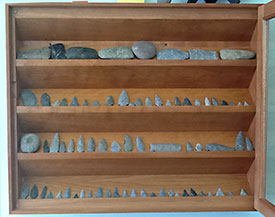New Haven
Prehistory
Written by Emma Stuhl
New Haven’s cultural history dates back to the first people who migrated north as the glaciers receded, over 10,000 years ago. Primarily nomadic hunters and gatherers, the people of this time period are today known as the Paleoindians. There is evidence that Paleoindians might have lived in or traveled through New Haven, as a resident found a Paleoindian arrowhead on his farm that was dated to be about 10,000 years old.
It is hard to say, however, whether the arrowhead was dropped by a Paleoindian or whether it was passed from generation to generation and abandoned or lost in more recent times.As the climate continued warming after the ice age, people settled into defined territories in an era known as the Archaic period from 9,500 to 3,000 years ago. In the following Woodland period, people began farming and they created permanent villages. The descendents of the Woodland people in Northern New England make up several distinct tribal groups, collectively called the Abenakis, a name given to them by French traders in Quebec. To learn more about this part of Vermont’s history, click here (link to Dummerston prehistory write up- it’s very general and detailed).
Residents of New Haven and visiting archeologists have found numerous American Indian artifacts, including arrowheads, knives, scrapers, hatchets, and a round grinding stone. A display of some of these artifacts is open to the public at the town hall.
Learn more about Vermont’s pre-European history in the Dummerston section.
